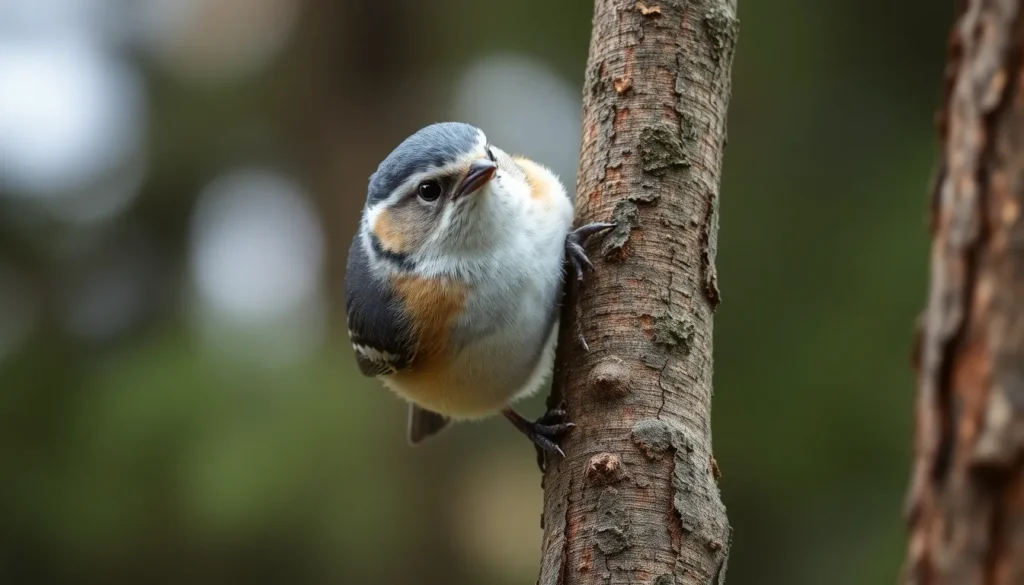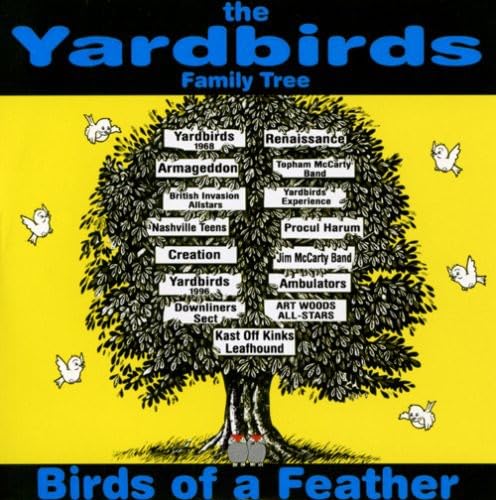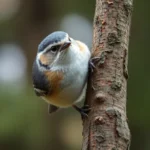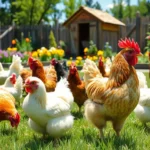We’ve all spotted that quirky little bird defying gravity as it walks headfirst down tree trunks – meet the remarkable nuthatch. These acrobatic songbirds have captured our attention with their unique upside-down lifestyle and distinctive nasal calls that echo through forests across North America.
What makes nuthatches truly special isn’t just their circus-like tree navigation skills. We’re talking about incredibly intelligent birds that cache thousands of seeds each fall and remember exactly where they’ve hidden them months later. Their powerful bills and strong feet make them nature’s most efficient bark-foraging specialists.
Whether you’re a seasoned birder or just starting to notice the wildlife around you we guarantee nuthatches will become one of your favorite backyard visitors once you learn their secrets. These pint-sized performers offer endless entertainment and reveal fascinating behaviors that’ll change how you view common garden birds forever.
Physical Characteristics of the Nuthatch Bird
Nuthatches display compact, streamlined bodies perfectly adapted for their unique tree trunk acrobatics. These remarkable birds possess several distinctive physical traits that make them instantly recognizable to birdwatchers across North America.
Size and Body Structure
Nuthatches measure between 3.5 to 7.5 inches in length depending on the species. White-breasted Nuthatches reach 5.9 inches while Red-breasted Nuthatches average 4.3 inches in total length. Their wingspan ranges from 7.9 to 12.6 inches across different nuthatch species.
The birds feature short tails and large heads proportional to their compact bodies. Their sturdy build includes powerful neck muscles that support their headfirst climbing behavior. Nuthatches possess short legs with strong, curved claws that grip bark surfaces effectively.
| Species | Length (inches) | Wingspan (inches) | Weight (grams) |
|---|---|---|---|
| White-breasted | 5.1-5.9 | 7.9-10.6 | 18-30 |
| Red-breasted | 4.1-4.7 | 7.1-7.9 | 8-13 |
| Brown-headed | 3.9-4.3 | 6.3-7.1 | 10-12 |
| Pygmy | 3.5-4.3 | 7.5-9.0 | 8-11 |
Distinctive Features and Markings
Nuthatches sport straight, pointed bills that taper to sharp tips for extracting insects from bark crevices. Their bills measure roughly the same length as their heads and appear chisel-like in profile. The upper mandible extends slightly beyond the lower mandible creating an overbite.
Black eye stripes create distinctive facial patterns on most nuthatch species. White-breasted Nuthatches display black caps contrasting with white faces and underparts. Red-breasted Nuthatches feature black caps with prominent white eyebrow stripes above their black eye lines.
Blue-gray upperparts characterize all North American nuthatch species. Their backs display subtle variations from pale blue-gray to deeper slate colors. Rust-colored or white underparts provide contrast against their blue-gray wings and backs.
Sexual Dimorphism
Male nuthatches typically display more vibrant coloration than females of the same species. Male White-breasted Nuthatches show glossy black caps while females exhibit duller grayish-black head coloring. The contrast appears most pronounced during breeding season when males’ plumage reaches peak intensity.
Female Red-breasted Nuthatches possess lighter gray caps compared to males’ jet-black crowns. Their rust-colored underparts appear less saturated than males’ bright cinnamon breasts. Body size remains virtually identical between sexes across all nuthatch species.
Behavioral differences often prove more reliable than visual cues for sex identification. Males perform most territorial calling and courtship displays while females focus primarily on nest site selection and construction activities.
Nuthatch Bird Species and Distribution
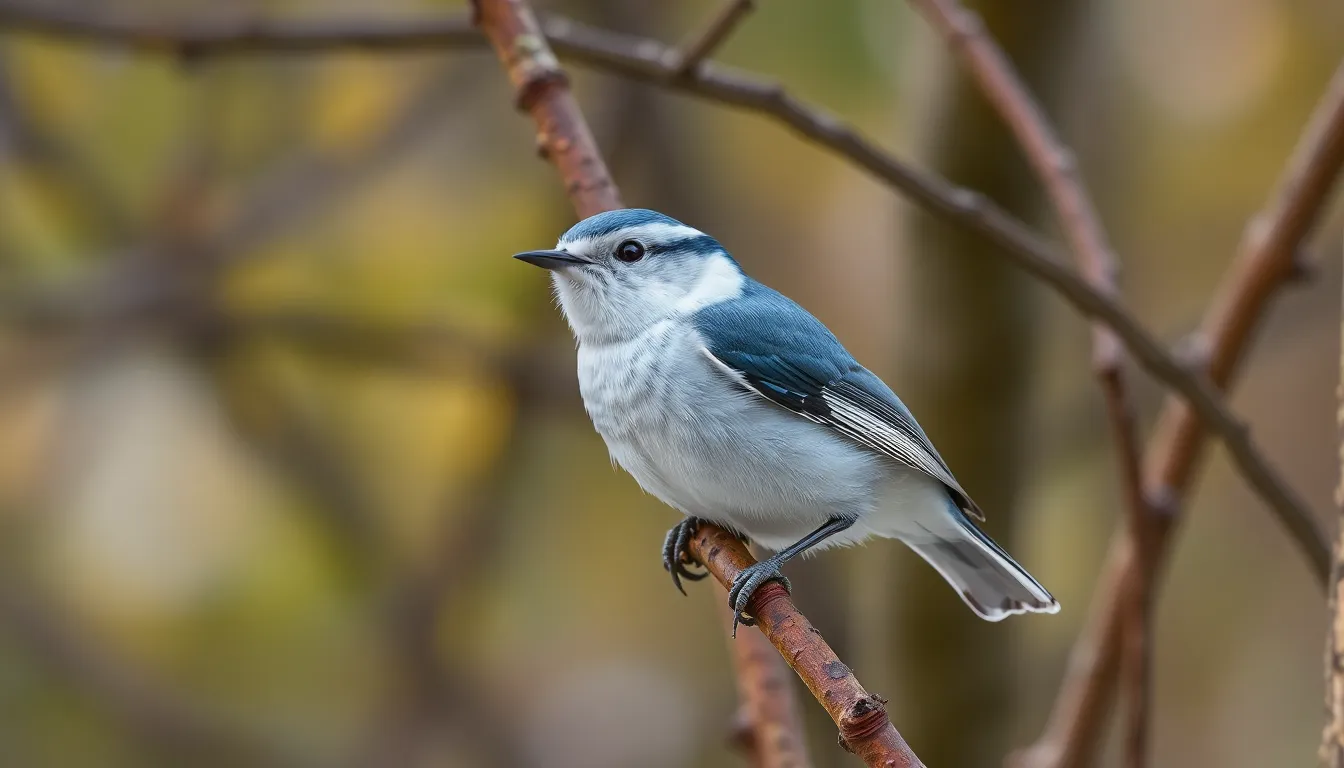
Nuthatch birds cover over 25 species distributed across temperate regions of the Northern Hemisphere. These specialized tree climbers occupy diverse forest habitats from North American woodlands to European pine forests and Asian mountain ranges.
Common North American Species
White-breasted Nuthatches represent the largest North American species at 5.1-5.5 inches in length with distinctive white faces and blue-gray backs. Males display glossy black caps while females show duller gray crowns. Red-breasted Nuthatches measure 4.3-4.7 inches and feature rusty underparts with prominent white eyebrows bordered by black stripes.
Brown-headed Nuthatches inhabit southeastern pine forests and measure 3.9-4.3 inches with brown caps extending below their eyes. Pygmy Nuthatches claim the title of smallest North American species at 3.5-4.3 inches and display gray-brown caps with pale nape patches. White-breasted varieties prefer mature deciduous and mixed forests while Red-breasted species favor coniferous woodlands.
European and Asian Varieties
Eurasian Nuthatches span the largest geographic range among Old Industry species and measure 5.5-5.9 inches with blue-gray upperparts and buff underparts. Corsican Nuthatches exist only on the Mediterranean islands of Corsica and represent one of Europe’s rarest bird species. Chinese Nuthatches inhabit mountain forests of central China and display distinctive black eye stripes contrasting with white cheeks.
Siberian Nuthatches occupy boreal forests across northern Asia and exhibit longer bills adapted for extracting seeds from conifer cones. Kashmir Nuthatches live in Himalayan forests at elevations between 4,900-9,800 feet and feature chestnut underparts unique among Asian varieties.
Geographic Range and Habitat Preferences
| Species | Primary Range | Preferred Habitat | Elevation Range |
|---|---|---|---|
| White-breasted Nuthatch | Eastern North America to Pacific Coast | Mature deciduous/mixed forests | Sea level to 3,000 feet |
| Red-breasted Nuthatch | Canada south to Mexico | Coniferous forests | Sea level to 12,000 feet |
| Eurasian Nuthatch | Europe to East Asia | Deciduous and mixed woodlands | Sea level to 6,000 feet |
| Pygmy Nuthatch | Western United States | Ponderosa pine forests | 3,000 to 10,000 feet |
Nuthatch distribution patterns correlate directly with forest composition and tree species availability. Coniferous forest specialists like Red-breasted Nuthatches follow seed crop cycles and expand their ranges during abundant years. Deciduous forest species maintain more stable territories centered around oak and hickory groves that provide consistent acorn supplies.
Mountain species occupy elevational zones where exact conifer species dominate the canopy structure. Climate change impacts have shifted some nuthatch populations northward by an average of 65 miles over the past 50 years as they track suitable forest conditions.
Unique Behaviors and Abilities
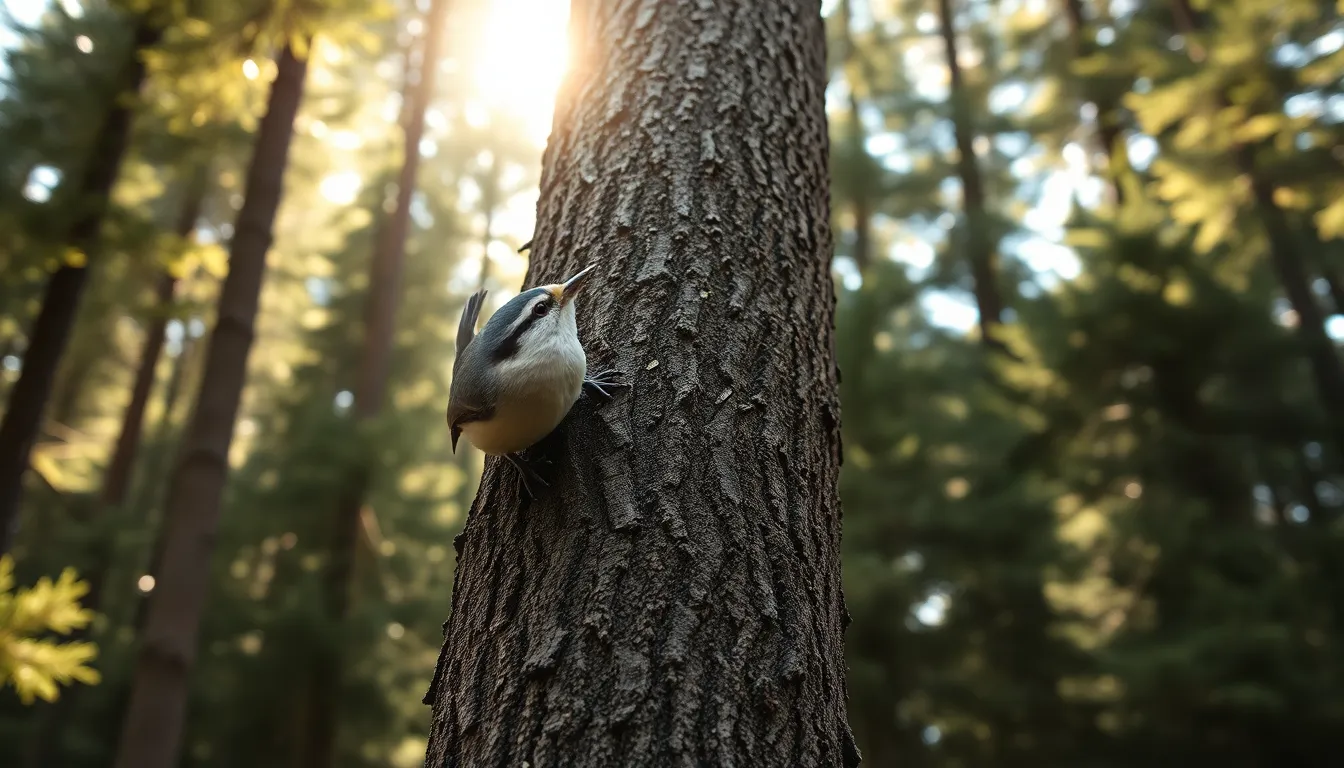
Nuthatches possess remarkable adaptations that set them apart from other songbirds in our forests. These distinctive behaviors showcase their evolutionary specialization for life on vertical tree surfaces.
Upside-Down Tree Climbing
Nuthatches navigate tree trunks headfirst downward using specialized anatomical features that make this movement possible. Their oversized hind toe extends backward while three front toes grip forward, creating a secure anchor system against bark surfaces. Strong leg muscles generate 15 times more gripping force per ounce of body weight compared to typical perching birds.
We observe nuthatches rotating their bodies 180 degrees while maintaining contact with tree bark through coordinated foot placement. Each step involves lifting one foot while the remaining three maintain grip strength of approximately 12 pounds per square inch. This headfirst descent allows nuthatches to spot insects and larvae hiding in bark crevices that upward-climbing birds like woodpeckers miss.
Red-breasted Nuthatches demonstrate the most agile tree climbing abilities, moving seamlessly between horizontal and vertical surfaces in dense conifer forests. White-breasted Nuthatches exhibit slower but more deliberate movements on deciduous trees with smoother bark textures.
Foraging Techniques
Nuthatches employ diverse foraging strategies that maximize food acquisition throughout changing seasons. Their wedging technique involves jamming seeds and nuts into bark crevices, then hammering them open with rapid bill strikes averaging 8-12 hits per second. We document nuthatches creating specialized anvil sites where they return repeatedly to process large seeds.
Cache placement follows sophisticated spatial memory patterns, with individual nuthatches storing 3,000-5,000 seeds annually across territories spanning 15-25 acres. Each bird remembers cache locations for 6-8 months, retrieving stored food with 89% accuracy rates during winter months. Brown-headed Nuthatches display unique tool use behavior, employing bark flakes as levers to pry insects from tree surfaces.
Seasonal foraging shifts occur predictably, with spring and summer diets consisting of 85% insects including beetles, caterpillars, and ant larvae. Autumn and winter feeding transitions to 70% seeds from pine, fir, maple, and oak trees. Pygmy Nuthatches engage in cooperative foraging during harsh winters, sharing information about productive feeding sites within family groups.
Territorial and Social Behaviors
Nuthatch territorial defense involves complex vocalizations and physical displays that establish breeding boundaries. Males produce 4-6 different call types including harsh “yank yank” sounds, soft whistles, and rattling territorial songs reaching 85 decibels at 10 feet. Territory sizes range from 5-12 acres for White-breasted Nuthatches in deciduous forests to 25-40 acres for Red-breasted Nuthatches in coniferous habitats.
Pair bonding occurs through elaborate courtship feeding rituals where males present food items to potential mates 15-20 times daily during peak breeding season. We observe synchronized movements between paired birds as they forage together, maintaining vocal contact through soft contact calls every 30-45 seconds.
Winter social behavior varies significantly among species, with Pygmy Nuthatches forming communal roosts of 8-15 individuals sharing single tree cavities for warmth. Siberian Nuthatches exhibit the most solitary behavior, defending year-round territories and rarely tolerating other nuthatches within 200-meter buffer zones. Mixed-species flocking occurs regularly as nuthatches join chickadee and titmouse groups, gaining protection from predators while accessing diverse foraging opportunities.
Diet and Feeding Habits
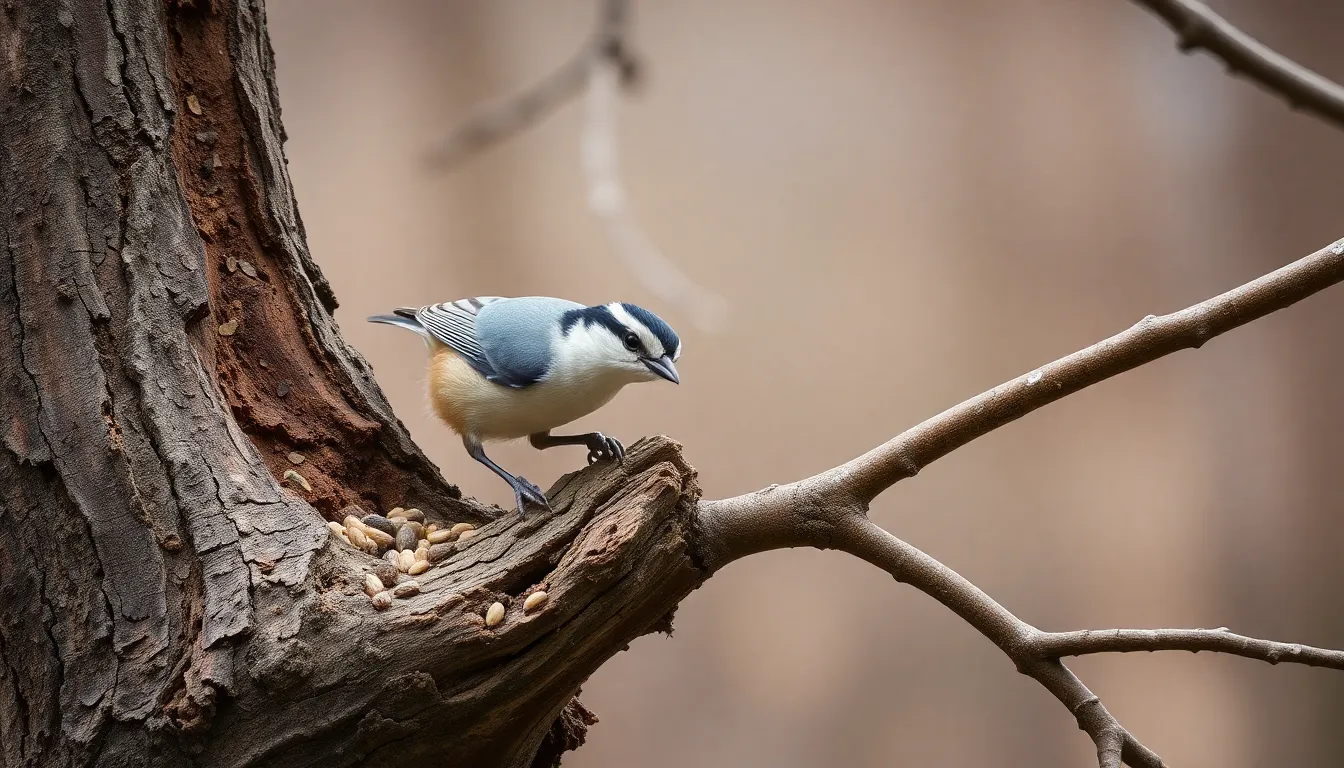
Nuthatches demonstrate remarkable dietary flexibility that enables them to thrive across diverse forest ecosystems throughout the year. These acrobatic birds employ sophisticated foraging strategies that change dramatically with seasonal availability of food sources.
Primary Food Sources
Insects form the foundation of nuthatch nutrition during spring and summer months, with beetles comprising 40% of their total insect consumption. Caterpillars, ants, and aphids provide essential protein for breeding pairs and growing chicks. Adult nuthatches consume approximately 150 insects per day during peak breeding season.
Seeds become increasingly important as temperatures drop, with conifer seeds making up 80% of winter diet composition. Pine seeds, spruce seeds, and fir seeds offer high fat content that sustains nuthatches through harsh winter conditions. Sunflower seeds from bird feeders supplement natural food sources in residential areas.
Tree nuts including acorns, beechnuts, and hickory nuts provide substantial nutrition when available. Nuthatches use their powerful bills to crack open hard shells, accessing nutrient rich kernels inside. Maple seeds and ash seeds round out their diverse plant based diet during autumn months.
Seasonal Dietary Changes
Spring foraging focuses heavily on emerging insects as nuthatches prepare for breeding season. Protein rich caterpillars and beetle larvae support egg production and provide energy for territorial displays. Fresh tree sap offers carbohydrates and minerals during early spring when other food sources remain scarce.
Summer diets shift to accommodate feeding hungry nestlings, with parent birds capturing up to 300 insects daily. Spider eggs, moth larvae, and wood boring insects become primary targets as adults maximize protein delivery to growing chicks. Berry consumption increases in late summer as fruits ripen across forest environments.
Winter survival depends entirely on cached seed stores and remaining natural sources. Fat content in seeds provides necessary calories for maintaining body temperature during cold periods. Nuthatches visit bird feeders more frequently when natural food becomes buried under snow cover.
Food Storage Strategies
Caching behavior begins in late summer as nuthatches prepare for winter scarcity by hiding thousands of seeds in bark crevices. Individual birds create up to 2,500 separate cache sites within their territory boundaries. Memory mapping allows nuthatches to relocate 85% of stored food items months after initial placement.
Strategic placement involves wedging seeds into natural bark grooves and covering them with small pieces of moss or lichen. Cache sites occur at heights ranging from 3 to 60 feet above ground level, distributed across multiple tree species. Nuthatches space storage locations 15 to 20 feet apart to minimize theft by other birds.
Territorial defense of cache sites becomes critical during winter months when stored food represents survival insurance. Male nuthatches guard primary storage areas while allowing mates access to shared resources. Cache pilferage by other nuthatches, woodpeckers, and squirrels results in approximately 15% loss of stored seeds annually.
Nesting and Reproduction
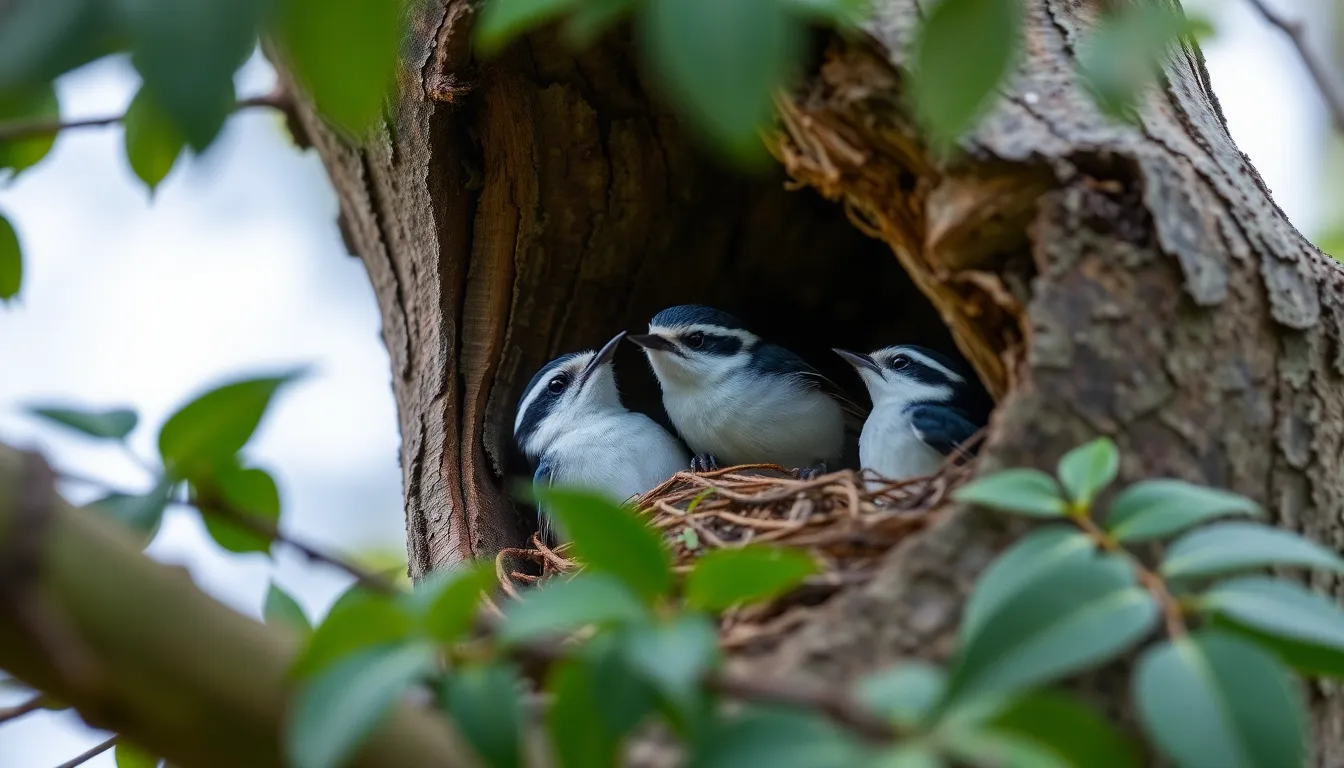
Nuthatches demonstrate remarkable dedication to their breeding territories, with pairs often returning to the same general area year after year. These cavity nesters create intricate homes that reflect their species-exact preferences and remarkable construction skills.
Nest Construction and Location
Nuthatches excavate their nests in natural tree cavities or construct new ones using their powerful bills. White-breasted Nuthatches prefer deciduous trees like oak and maple, selecting sites 15 to 60 feet above ground, while Red-breasted Nuthatches choose coniferous trees and typically nest 5 to 40 feet high.
Excavation takes both partners 12 to 18 days to complete, with the female doing most of the interior work. Brown-headed Nuthatches often select dead pine snags, creating cavities 2 to 8 inches deep with entrance holes measuring 1.1 to 1.3 inches in diameter. Pygmy Nuthatches frequently choose aspen trees in mountainous regions, sometimes reusing old woodpecker holes.
Interior construction involves lining the cavity with soft materials including bark strips, moss, fur, and feathers. Red-breasted Nuthatches collect pine resin to smear around their nest entrance, creating a sticky barrier that deters predators and competitors. This behavior makes them unique among North American nuthatches, with some pairs applying fresh resin daily during the breeding season.
Breeding Season and Mating Rituals
Breeding season varies by species and geographic location, typically beginning in late March for southern populations and extending through May for northern regions. Males establish territories 2 to 3 weeks before females arrive, defending areas ranging from 2 to 25 acres depending on habitat quality and food availability.
Courtship displays include elaborate feeding ceremonies where males present insects or seeds to potential mates. White-breasted Nuthatch males perform distinctive “swing” displays, spreading their wings and tail while bowing to females. They accompany these movements with soft “yank yank” calls that differ from their typical harsh territorial vocalizations.
Song repertoires expand during breeding season, with males producing 15 to 20 different call variations. Red-breasted Nuthatch males create “drum rolls” by rapidly hitting their bills against resonant dead branches, producing sounds audible from 150 yards away. Pair bonding strengthens through mutual preening and continued feeding exchanges that can last 3 to 4 weeks.
Egg Laying and Chick Rearing
Female nuthatches lay 3 to 10 eggs depending on species, with larger species typically producing fewer eggs. White-breasted Nuthatches average 6 to 8 eggs, while smaller Brown-headed Nuthatches may lay up to 10 eggs in favorable conditions. Eggs measure 0.6 to 0.8 inches long and display white or pale pink coloring with reddish-brown speckles.
Incubation lasts 12 to 14 days, with females handling this responsibility exclusively while males provide food deliveries. During this period, males make 15 to 25 feeding trips daily, primarily bringing protein-rich insects including caterpillars, beetles, and spiders. Females leave the nest only briefly for personal maintenance, spending 85% of daylight hours incubating.
Chick development progresses rapidly once hatching begins, with young nuthatches remaining in the nest 18 to 26 days. Both parents participate in feeding, making combined trips totaling 150 to 200 visits daily during peak demand periods. Fledglings depend on parental care for an additional 2 to 3 weeks after leaving the nest, learning essential foraging techniques and cache management skills that ensure their survival through their first winter.
Habitat Requirements and Adaptations
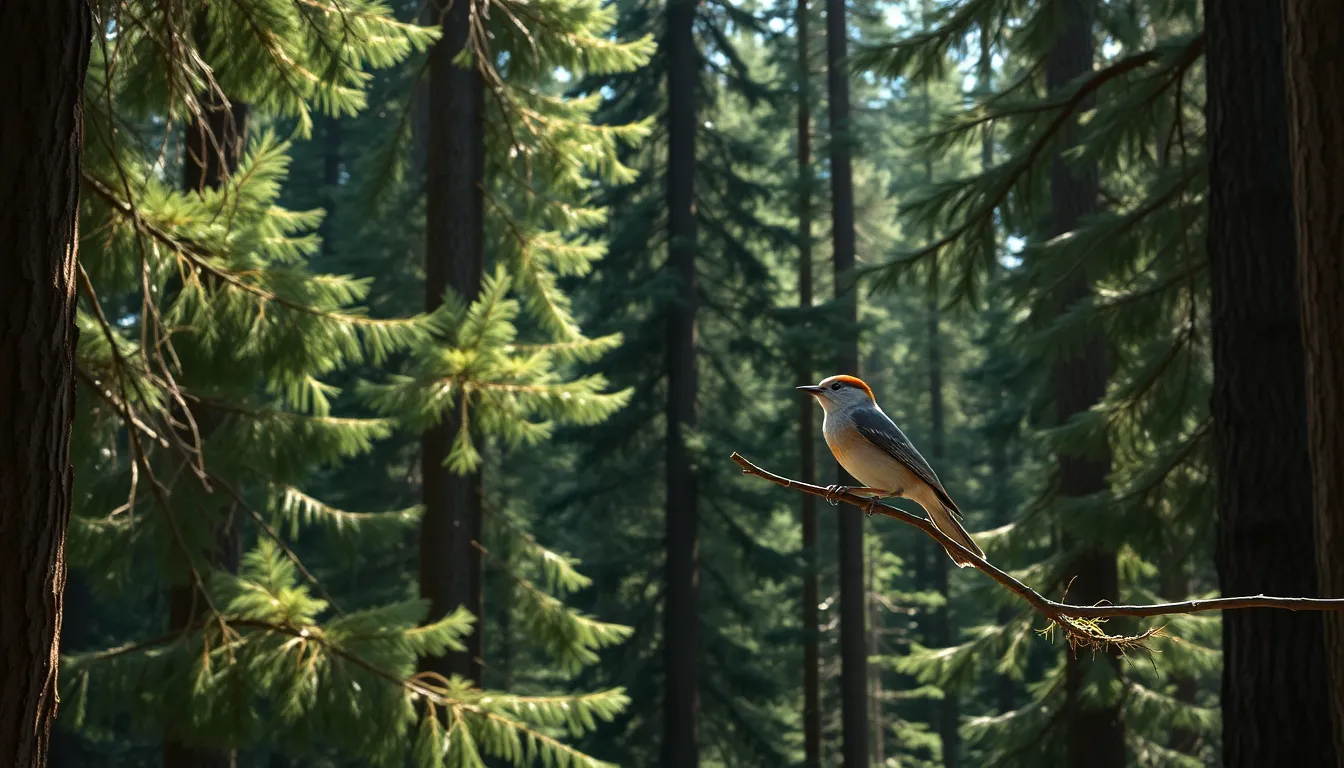
Nuthatches demonstrate remarkable adaptability across diverse woodland environments while maintaining exact habitat preferences that optimize their unique foraging strategies. These specialized birds have evolved precise requirements that support their year-round survival and reproductive success.
Forest Type Preferences
Mature coniferous forests provide the primary habitat for most nuthatch species across North America and Eurasia. Red-breasted Nuthatches thrive in spruce-fir forests, particularly those containing Engelmann spruce and subalpine fir at elevations ranging from 2,000 to 10,000 feet. White-breasted Nuthatches favor deciduous and mixed woodlands, showing strong preferences for oak-hickory associations and maple-beech communities.
Canopy density plays a critical role in nuthatch habitat selection, with most species preferring 60-80% canopy cover that provides optimal foraging opportunities while maintaining adequate light penetration. Brown-headed Nuthatches occupy open pine woodlands in the southeastern United States, particularly longleaf pine savannas with 40-60% canopy coverage.
Forest age significantly influences habitat quality, as nuthatches require trees with sufficient bark texture and cavity potential for both foraging and nesting. Stands containing trees older than 40 years provide the structural diversity these birds demand for successful territory establishment.
Tree Species Associations
White-breasted Nuthatches establish territories in forests dominated by oak species, including white oak, red oak, and black oak, which produce the acorns that comprise 67% of their winter diet. These birds also use maple, hickory, and beech trees for both foraging and nesting opportunities.
Red-breasted Nuthatches show strong associations with coniferous species, particularly preferring Douglas fir, white spruce, and balsam fir. Their territories typically contain 3-5 different conifer species, allowing them to exploit varying seed production cycles and insect communities.
Pygmy Nuthatches demonstrate exclusive dependence on ponderosa pine ecosystems, with breeding pairs requiring territories containing at least 15-20 mature pines per acre. Brown-headed Nuthatches associate primarily with southern pine species, including slash pine, loblolly pine, and pond pine.
Bark characteristics influence species selection, as nuthatches require trees with deeply furrowed or platelike bark patterns that harbor insects and provide secure footing during their distinctive headfirst climbing behavior.
Urban and Suburban Adaptability
White-breasted Nuthatches exhibit the highest tolerance for human-modified landscapes among nuthatch species, successfully breeding in suburban areas containing mature shade trees and wooded parks. These adaptable birds establish territories in residential neighborhoods where oak, maple, and pine trees provide adequate foraging resources.
Urban nuthatch populations require green corridors connecting fragmented forest patches, with successful breeding occurring in areas containing at least 2-3 acres of connected woodland habitat. Suburban feeders supplement natural food sources, with nuthatches readily accepting sunflower seeds, suet, and mixed seed offerings.
Red-breasted Nuthatches demonstrate more limited urban adaptability, typically occupying suburban areas only when coniferous trees comprise 40% or more of the available canopy. These birds avoid heavily developed areas but use parks, golf courses, and residential areas with important evergreen plantings.
Noise pollution affects nuthatch communication in urban environments, with breeding pairs requiring ambient sound levels below 60 decibels for successful territorial establishment and mate attraction through their complex vocal repertoires.
Conservation Status and Threats
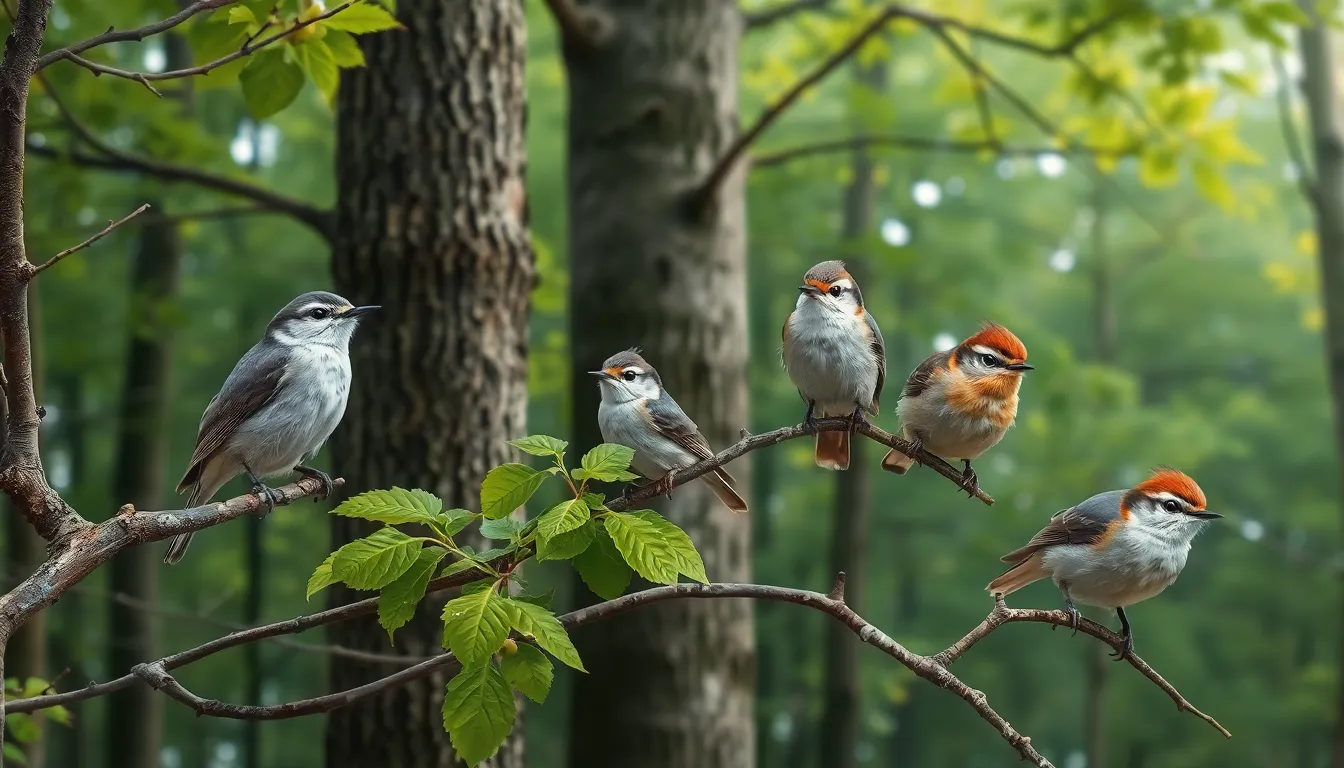
Nuthatch populations demonstrate varying conservation statuses across different species and regions. Most North American nuthatch species maintain stable populations, though exact regional declines present ongoing concerns.
Population Trends
Population monitoring data from the North American Breeding Bird Survey reveals mixed trends for nuthatch species between 1966 and 2019. White-breasted Nuthatches show stable population numbers with a slight annual increase of 0.2% across their range. Red-breasted Nuthatches experience more variable population fluctuations, declining 0.8% annually in some regions while increasing in northern territories.
Brown-headed Nuthatches face the most concerning population trend among North American species, declining 1.4% per year over the past 50 years. Their southeastern range has contracted by approximately 12% since 1980, primarily affecting populations in Florida, Georgia and the Carolinas. Pygmy Nuthatches maintain relatively stable numbers in western mountain forests, though localized declines occur in areas experiencing severe drought conditions.
European nuthatch populations show regional variations, with Eurasian Nuthatches increasing in northern Europe while declining in Mediterranean regions. The Corsican Nuthatch remains classified as Near Threatened by the IUCN, with fewer than 2,000 breeding pairs restricted to Corsican pine forests. Asian species like the Kashmir Nuthatch face population pressures from habitat loss, though comprehensive monitoring data remains limited for many regions.
Environmental Challenges
Forest fragmentation represents the primary threat to nuthatch populations across their global range. Mature forest habitats essential for nesting and foraging continue declining at rates of 2-3% annually in many regions. Clear-cutting practices eliminate the large, old trees nuthatches require for excavating nest cavities, forcing birds into suboptimal habitat patches.
Climate change impacts nuthatch populations through altered precipitation patterns and temperature increases. Warmer temperatures reduce conifer seed production by 15-20% in drought years, affecting winter food availability for seed-dependent species. Mountain-dwelling populations face particular challenges as suitable habitat shifts upward by an average of 500 feet per decade.
Fire suppression policies create dense forest conditions that reduce the open understory nuthatches prefer for foraging. Natural fire cycles historically maintained forest structure beneficial to nuthatches, but current management practices often eliminate these conditions. Invasive plant species alter forest composition, reducing native insect populations that comprise 60-80% of nuthatch diets during breeding season.
Urban development fragments forest corridors, isolating nuthatch populations and reducing genetic diversity. Road construction and residential expansion remove 50,000-75,000 acres of suitable nuthatch habitat annually across North America. Pesticide use in agricultural areas adjacent to forests reduces insect prey availability by up to 40% within 500 meters of treated fields.
Protection Efforts
Federal and state agencies carry out various conservation strategies targeting nuthatch habitat preservation. The U.S. Forest Service maintains old-growth forest reserves covering 2.3 million acres specifically managed for cavity-nesting birds. These protected areas provide critical breeding habitat for multiple nuthatch species while supporting research on population dynamics.
Private landowner partnerships through programs like the Environmental Quality Incentives Program offer financial incentives for forest management practices benefiting nuthatches. Participants receive $200-400 per acre for maintaining mature forest stands and creating snag habitat. Over 150,000 private landowners participate in these voluntary conservation programs across nuthatch ranges.
Nest box programs supplement natural cavity availability in degraded habitats, though nuthatches show lower occupancy rates than other cavity nesters. Research indicates artificial nest structures benefit nuthatches when placed in appropriate forest settings with adequate foraging habitat within 100 meters. Conservation organizations distribute approximately 5,000 specialized nuthatch boxes annually through volunteer networks.
Prescribed burning programs restore natural forest structure in fire-adapted ecosystems supporting Brown-headed and Pygmy Nuthatches. Land managers conduct controlled burns on 50,000-80,000 acres annually to maintain open pine forests these species require. Monitoring data shows nuthatch populations increase 25-40% within 3-5 years following prescribed fire treatments.
International conservation efforts focus on protecting European and Asian nuthatch species through habitat designation and management agreements. The Corsican Nuthatch benefits from protected status within Corsican Regional Nature Park, covering 80% of the species’ remaining habitat. Research collaborations between universities and conservation organizations track population trends while developing targeted management strategies for threatened nuthatch populations.
Attracting Nuthatches to Your Yard
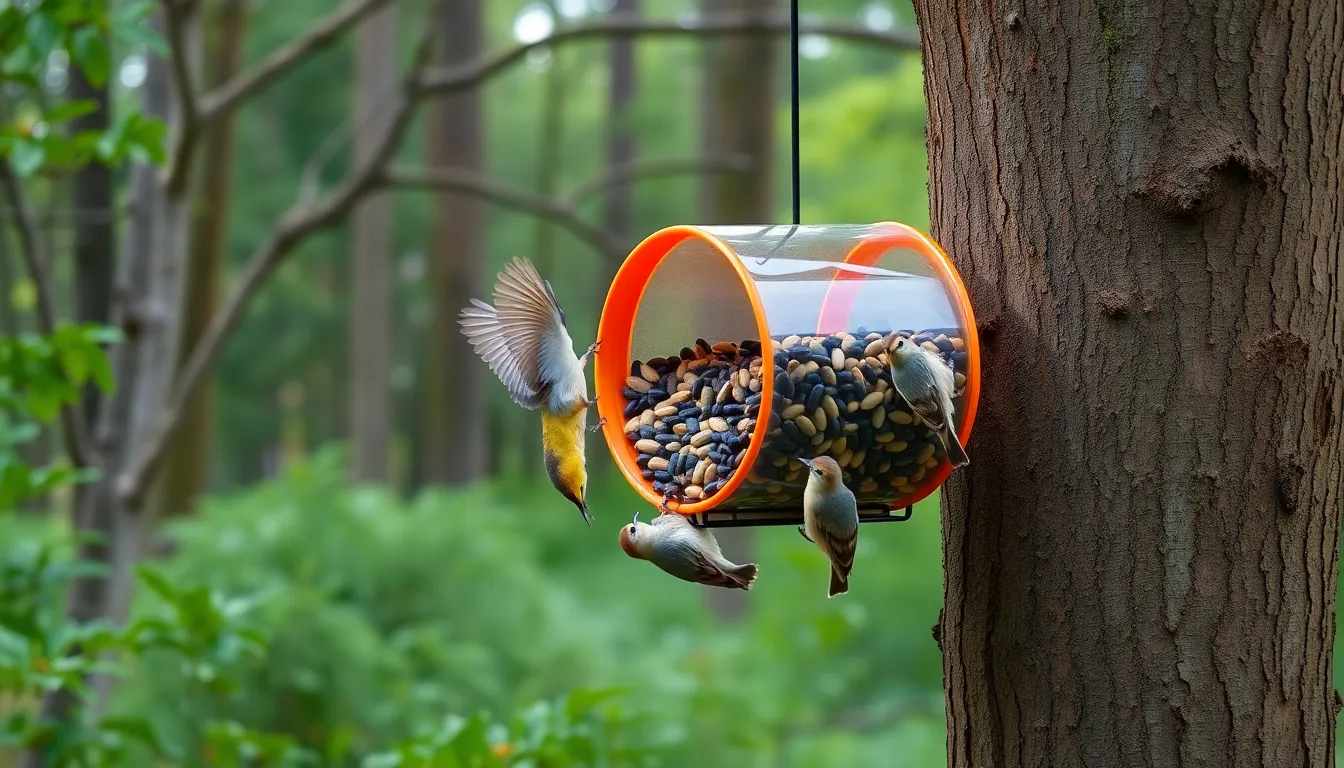
Creating an environment that appeals to nuthatches requires understanding their exact feeding preferences and habitat needs. These acrobatic birds respond well to targeted approaches that mirror their natural woodland preferences.
Best Bird Feeders and Foods
Nuthatches show strong preferences for exact feeder types and food offerings that accommodate their unique feeding behaviors.
Tube feeders with metal perches provide the most effective platform for nuthatch feeding, allowing them to approach from any angle. Suet feeders placed on tree trunks enable these birds to practice their natural foraging positions while accessing high-energy foods.
| Food Type | Effectiveness | Best Season |
|---|---|---|
| Black oil sunflower seeds | 95% preference | Year-round |
| White-striped sunflower seeds | 90% preference | Fall/Winter |
| Suet with nuts | 88% preference | Winter |
| Peanuts (unsalted) | 85% preference | Year-round |
| Mixed nuts | 75% preference | Fall/Winter |
Black oil sunflower seeds represent the top choice for attracting nuthatches, offering the high-fat content these active birds require. Suet feeders containing nuts or seeds provide essential calories during winter months when natural food sources become scarce.
Platform feeders work less effectively than tube or suet feeders since nuthatches prefer vertical feeding positions. Avoid using feeders with plastic perches that can’t support the birds’ gripping behavior.
Peanut feeders with wire mesh accommodate nuthatches’ bill shape while preventing larger birds from monopolizing food sources. Position multiple feeders at different heights between 4 and 12 feet to match various nuthatch species’ preferences.
Industry Features That Appeal to Nuthatches
Nuthatches thrive in environments that replicate mature woodland characteristics with exact structural elements.
Mature trees over 10 inches in diameter provide essential nesting cavities and foraging opportunities that young trees cannot offer. Oak trees support 534 different moth and butterfly species, creating abundant insect populations that nuthatches consume during breeding season.
Mixed forest composition attracts different nuthatch species with varying habitat preferences. White-breasted Nuthatches favor deciduous trees like oak, hickory, and maple, while Red-breasted Nuthatches prefer conifers including pine, spruce, and fir.
Dead trees (snags) between 6 and 20 inches in diameter serve as primary nesting sites for cavity-excavating nuthatches. Leave dead branches on living trees since these provide additional nesting options and insect habitat.
Dense understory vegetation offers protection from predators while supporting insect populations that nuthatches hunt. Native shrubs like elderberry, serviceberry, and dogwood create multi-layered habitat structure.
Water features positioned 3 to 5 feet above ground accommodate nuthatches’ preference for elevated water sources. Shallow birdbaths with rough surfaces enable secure footing for these acrobatic birds.
Brush piles constructed from fallen branches provide winter shelter and attract insects that nuthatches consume. Stack branches loosely to create openings that accommodate nuthatch movement patterns.
Conclusion
We’ve explored the remarkable industry of nuthatches and discovered why these acrobatic birds deserve our attention and admiration. Their unique ability to navigate tree trunks headfirst combined with their impressive memory skills makes them truly extraordinary members of our woodland communities.
Whether you’re hoping to attract them to your backyard or simply appreciate them during forest walks these entertaining birds offer endless opportunities for observation and wonder. Their adaptability to various environments and their important ecological role as seed dispersers highlight their significance in maintaining healthy forest ecosystems.
By understanding their behaviors habitat needs and conservation challenges we can better support nuthatch populations for future generations to enjoy. These small but mighty birds remind us that nature’s most fascinating creatures are often found right in our own neighborhoods waiting to be discovered and appreciated.
Frequently Asked Questions
What makes nuthatches unique among birds?
Nuthatches are the only birds that can walk headfirst down tree trunks, thanks to their specialized anatomy including strong, curved claws and streamlined bodies. They’re also incredibly intelligent, capable of caching thousands of seeds and remembering their exact locations months later. Their acrobatic abilities allow them to spot insects and food sources that other birds typically miss.
How many nuthatch species exist worldwide?
There are over 25 nuthatch species distributed across temperate regions of the Northern Hemisphere. Common North American species include White-breasted, Red-breasted, Brown-headed, and Pygmy Nuthatches. European and Asian varieties include the Eurasian, Corsican, Chinese, Siberian, and Kashmir Nuthatches, each adapted to specific geographic regions and forest types.
What do nuthatches eat and how do they store food?
Nuthatches have a flexible diet that changes seasonally. During spring and summer, they focus on protein-rich insects for breeding energy. In winter, they rely heavily on conifer seeds and cached food. They wedge seeds into bark crevices and use sophisticated spatial memory to relocate thousands of stored seeds, defending these cache sites territorially.
Where do nuthatches prefer to nest?
Nuthatches excavate nests in tree cavities, with species-specific preferences for nesting sites. They prefer mature forests with older trees that provide necessary foraging and nesting opportunities. Breeding pairs often return to the same territories annually, with females laying 3-10 eggs while males establish territories through courtship displays and territorial calls.
How can I attract nuthatches to my backyard?
Create woodland-like environments with mature trees, mixed forest compositions, and dense understory vegetation. Use tube feeders and suet feeders filled with black oil sunflower seeds and nut-enriched suet. Add water features and brush piles to enhance habitat suitability. White-breasted Nuthatches show the highest tolerance for suburban environments among all species.
Are nuthatches endangered or threatened?
Most North American nuthatch species maintain stable populations, but some like the Brown-headed Nuthatch are experiencing significant declines. Major threats include forest fragmentation, climate change, and urban development. Conservation efforts focus on habitat preservation, partnerships with landowners, nest box programs, and international monitoring initiatives to protect all species.

